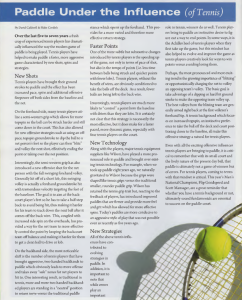Paddle under the influence…..of Tennis
David Caldwell & Blake Cordish had thoughts on the subject:
Over the last five to seven years a fresh crop of experienced tennis players has dramatically influenced the way the modern game of paddle is being played. Tennis players have helped to make paddle a faster, more aggressive game characterized by new shots, spins and strategies.
New Shots
Tennis players have brought their ground strokes to paddle and the effect has been increased pace, spins and additional offensive firepower off both sides from the baseline and the net.
On the forehand side, many tennis players utilize a semi-western grip that allows for more topspin so the ball can be struck harder and still come down in the court. This has also allowed for new offensive strategies such as using an off-pace, topspin groundstroke to dip the ball to a net person’s feet so the player can then “blitz” and volley the next shot, effectively ending the point or taking over the net position.
Interestingly, the semi-western grip has also introduced a new offensive shot for the net person with the full swinging forehand volley. Generally hit off of a short lob, this swinging volley is actually a forehand groundstroke hit with tremendous velocity targeting the feet of the baseliner. The goal is to aim at the backcourt player’s feet so he has to take a half-step back to avoid being hit, thus making it harder for his team to track down the next ball after it comes off the back wire. This, coupled with increased side spin on the overheads, has provided a way for the net team to more effectively control the point by keeping the backcourt team off balance and making it harder for them to get a clean ball to drive or lob.
On the backhand side, the most noticeable shift is the number of tennis players that have brought aggressive, two-handed backhands to paddle that obviously leads to more offense and takes away “safe” zones for net players to hit to. One interesting result, as traditional in tennis, more and more two-handed backhanded players are standing in a “neutral” position to return serve versus the traditional paddle stance that opens up the forehand. This provides for a more varied and therefore more effective return strategy.
Faster Points
One of the more subtle but substantive changes introduced by tennis players is the speeding up of the game, not only in terms of pace of shot, but also in the tempo of points (i.e. less time between balls being struck and quicker points with fewer lobs). Tennis players, without the benefit of wires, are obviously conditioned to take the balls off the deck. As a result, fewer balls are being left to the back wire.
Interestingly, tennis players are much more likely to “control” a point from the baseline with drives than they are lobs. It is certainly not clear that this strategy is necessarily the most effective, but it does make for a faster paced, more dynamic game, especially with four tennis players on the court.
New Technology
Along with the players, major tennis equipment suppliers like Wilson, have played a more pronounced role in paddle and brought over existing tennis technology. For example, when we took up paddle eight years ago, we naturally gravitated to Wilson because the grips were shaped like tennis grips versus the traditional smaller, rounder paddle grip. Wilson has retained the tennis grip trait but, reacting to the feedback of players, has introduced improved paddles that are firmer and provide more feel and grit that has allowed for more effective spins. Today’s paddles are more conducive to an aggressive style of play that was not possible even as recently as five years ago.
New Strategies
All of the above tennis influences have contributed to evolving strategies in paddle. In addition, it is important to note that while errors play an important role in tennis, winners do as well. Tennis players bring to paddle an instinctive desire to figure out a way to end points. In some ways, it is the Achilles heel of tennis players when they first take up the game, but this mindset has also helped to evolve and improve the game as tennis players creatively look for ways to win points versus avoiding losing them.
Perhaps, the most pronounced and most exciting trend is the growing importance of “blitzing” or opportunistically charging the net to volley an opposing team’s volley. The basic goal is take advantage of a dipping or hard hit groundstroke to make the opposing team volley up. The best volleys from the blitzing team are generally aimed right back at the first volleyer’s forehand hip. A tennis background which focuses on increased topspin, an instinctive preference to take the ball off the deck and court positioning closer to the baseline, all make this offensive strategy a natural for tennis players.
Even with all the exciting offensive influences tennis players are bringing to paddle, it is critical to remember that with its small court and the lively nature of the present day ball, that paddle is ultimately not a game of winners but of errors. For tennis players, coming to terms with that mindset is critical. This year’s Men’s National Champions, Flip Goodspeed and Scott Mansager, are a great reminder that whether you have a tennis background or not, ultimately sound fundamentals are essential to success on the paddle court.




